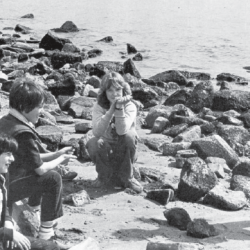Source Institutions
Source Institutions
Add to list Go to activity
Activity link broken? See if it's at the internet archive

In this outdoor activity, learners become beachcombers as they walk on a sandy beach in search of evidence of life. Learners gather examples and consider how the collected artifacts reached the beach. Learners then match their artifacts with the living organism that created each, while also telling stories about how the artifact might have been used. This activity can be done with learners of various ages, but the level of details in identifying and describing what its found can be varied according to age.
- 5 to 10 minutes
- 45 to 60 minutes
- $1 - $5 per group of students
- Ages 4 - 14
- Activity, Field Trip
- English
Quick Guide
Materials List (per group of students)
- containers (plastic bags, dishpans, buckets, or cut-off milk cartons)
- magnifying lenses or bug boxes
- Aquatic Observation Aids Equipment Card (from PDF)
Subjects
-
Earth and Space Science
-
Earth Structure
- Oceans and Water
-
Earth Structure
-
Life Sciences
-
Diversity of Life
- Plants
- Animals
-
Ecology
- Ecosystems
- Human Impact
-
Diversity of Life
-
The Nature of Science
-
The Scientific Process
- Asking Questions
- Gathering Data
- Formulating Explanations
- Communicating Results
-
The Scientific Process
Informal Categories
- Animals
- Nature and Environment
- Outdoor Activity
- Physical Activity
Audience
To use this activity, learners need to:
- see
- be mobile
- touch
Learning styles supported:
- Involves teamwork and communication skills
- Involves hands-on or lab activities
Other
This resource is part of:
Access Rights:
- Free access
By:
Rights:
- All rights reserved, The Regents of the University of California, 1981
